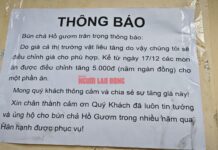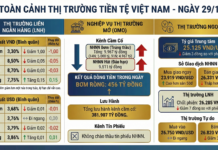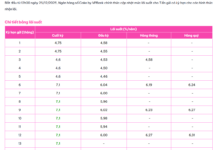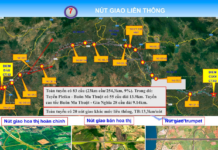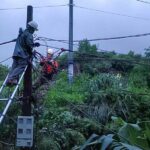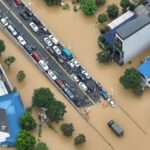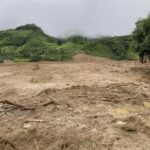
Devastating floods in Vietnam cause extensive damage to agriculture and infrastructure.
According to the Rapid Report on Flood Prevention and Control issued on September 8th, and released on September 9th, by the Department of Dike Management and Flood Control, as of 6 am on September 9th, 113,593 hectares of rice fields were flooded and damaged. The affected areas include Hai Phong (7,005 ha), Thai Binh (18,000 ha), Hanoi (15,563 ha), Hung Yen (12,119 ha), Hai Duong (18,500 ha), Ha Nam (11,220 ha), Lang Son (3,688 ha), Bac Giang (4,822 ha), Bac Ninh (9,601 ha), and Vinh Phuc (6,000 ha), among others.
22,047 hectares of crops were also flooded and damaged, with significant impacts in Hai Phong (1,600 ha), Nam Dinh (2,500 ha), Thai Binh (3,345 ha), Hanoi (1,205 ha), Bac Ninh (2,293 ha), Hai Duong (2,900 ha), Hoa Binh (4,193 ha), and Lang Son (1,136 ha).

Flooded fields and damaged infrastructure in the aftermath of the storm.
Additionally, 6,887 hectares of fruit trees were damaged, an increase of 1,860 hectares compared to the report on September 7th. The affected areas include Hai Phong (1,650 ha), Thai Binh (1,385 ha), Hung Yen (1,841 ha), Hai Duong (900 ha), and Nghe An (798 ha). 121,668 trees were uprooted, with significant numbers in Hai Phong (6,059), Hanoi (24,807), Hung Yen (9,036), Hai Duong (40,000), and Bac Ninh (31,860).
The storm also took a toll on over 1,500 fish cages (an increase of 384 cages since the September 7th report), which were damaged or swept away, particularly in Quang Ninh (1,000) and Hai Duong (300). 79 livestock and 190,131 poultry were affected, with the majority in Hai Duong (186,000 poultry).
Multiple Provinces Experienced Power and Communication Outages due to the Storm
25 boats of various types sank at their moorings in Quang Ninh. Quang Ninh, Hai Phong, Thai Binh, Hai Duong, and Hanoi experienced widespread power and communication outages.
Due to the prolonged duration of the storm and the intense wind speeds, 9,851 houses were damaged. Additionally, 12 sections of 500kV power lines, 36 sections of 220kV lines, and 161 sections of 110kV lines were affected by the storm, and numerous low-voltage power poles were toppled.

Downed power lines and damaged infrastructure in the aftermath of the storm.
Many shops, offices, and schools suffered roof damage, and numerous advertising signs, telecommunication poles, and mobile transmission stations were toppled. Urban trees were uprooted and strewn across roads in the provinces of Quang Ninh, Hai Phong, Hai Duong, and Hanoi.
“The localities are continuing to assess and tally the damage,” the report stated.
The Ministry of Industry and Trade issued Official Dispatch No. 6815/CD-BCT on September 8, 2024, regarding the strengthening of market inspection and supervision after Storm No. 3. Official Dispatch No. 6814/CD-BCT, issued on September 7, directed the Vietnam Electricity Group and local authorities to repair storm damage and restore power to the people. As of September 8, the Vietnam Electricity Group had restored 3 out of 12 500kV power lines and 21 out of 36 220kV lines. Local electricity units also restored 94 out of 161 110kV lines (Hai Phong 30/38, Quang Ninh 11/59, Hai Duong 37/44, Thai Binh 4/4, Bac Giang 7/9, and Bac Ninh 5/7).

The Vietnamese government has provided emergency support to the affected regions.
The government has provided emergency support to the affected regions. They allocated 20 billion VND from the central budget’s reserve fund for 2024 to assist Son La and Dien Bien (10 billion VND each) in stabilizing the lives of their citizens after the floods, as proposed by the Ministry of Finance.
The Prime Minister also directed that each of the heavily affected provinces, Quang Ninh and Hai Phong, be supported with approximately 100 billion VND for post-storm recovery.
Storm No. 3 (Yagi) was an extraordinary storm that formed east of the Philippines but intensified into a super typhoon in the South China Sea. It was the strongest typhoon in the South China Sea in the past 30 years.
The maximum wind speed near the storm’s eye was recorded at Level 16, with gusts above Level 17. When it made landfall in Quang Ninh and Hai Phong, the wind speed was recorded at Level 13-14, with gusts at Level 16-17.
*In China, Typhoon Yagi caused an estimated damage of over $8 billion. Infrastructure damage to roads, waterways, civil aviation, and transportation projects under construction across Hainan amounted to a total of 728 million yuan (approximately $102.6 million).
As of 5 pm on September 7, the capital city of Haikou had evacuated about 105,500 residents due to the storm. More than 400 houses collapsed, and over 32,000 houses were damaged. Additionally, 167,800 trees in the city were uprooted, and 56,742 hectares of crops were affected, resulting in direct economic losses of over 26.3 billion yuan (over $3.6 billion).
The total economic losses in Wenchang City caused by Yagi reached 32.7 billion yuan ($4.5 billion).
The Power is Back: 3 Provinces and Cities Have Their Electricity Restored
As of September 10th, the power grid affected by Storm No. 3 in Quang Ninh province, Hai Phong city and Hai Duong province has been substantially restored. Essential services such as hospitals, communication networks and clean water supplies have had their power restored.
The Sweet Success of Vietnam’s Sugarcane Industry: Climbing to the Top
Since 2021, Vietnam’s domestic sugar industry has been witnessing a resurgence, following the implementation of trade defense measures on imported sugarcane products. Between 2011 and 2021, sugarcane fields witnessed a decline from 283,000 hectares in the 2011/12 crop year to just 146,938 hectares in the 2021/22 crop year. However, in the last three years, there has been a notable turnaround, with sugarcane fields now covering nearly 175,000 hectares, indicating a sweet revival for the industry.
The Devastating Floods in Northern Vietnam: An Urgent Crisis
The Vice Minister of Agriculture and Rural Development has issued a statement regarding the severe flooding in the northern provinces. The official stressed the urgency of the situation, urging local authorities to take proactive and aggressive action to support and safeguard the lives and property of those affected.
The Road Less Travelled: Uncovering the Beauty of the Thai Nguyen – Cho Moi Highway
The Vietnam Road Administration reports that the Thai Nguyen – Cho Moi Highway in Thai Nguyen City is currently experiencing severe flooding, with water levels reaching depths of 0.6 to 1.2 meters. This has resulted in significant traffic disruptions, and all vehicles traveling through this area have been temporarily halted.
Deadly Landslides and Floods Claim Hundreds of Lives
As of 7 a.m. on September 11, 2024, the reported damage caused by Typhoon No. 3 and the subsequent flood and rain included over 200 casualties, with 141 confirmed deaths and a minimum of 59 missing persons, according to the Department of Dyke Management and Disaster Prevention (Ministry of Agriculture and Rural Development).




